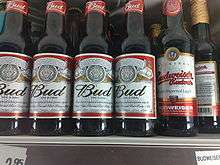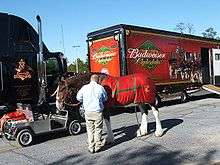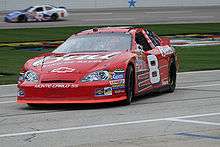Budweiser (AB InBev)
Budweiser (/ˈbʌdwaɪzər/) is an American-style pale lager produced by Anheuser-Busch, currently part of the transnational corporation AB InBev and produced in various breweries around the world.[1] There is an unrelated lager also called Budweiser, originating centuries ago in České Budějovice, Czechia (historically known as Budweis); the existence of the two separate beers has given rise to a trademark dispute preventing Anheuser-Busch from using the "Budweiser" name in some regions, leading to the exclusive use of "Bud" in those markets.
 | |
| Type | American lager |
|---|---|
| Country of origin | United States |
| Introduced | 1876 (in St. Louis, Missouri, United States) |
| Alcohol by volume | 5%, USA (3% only Jimmy Murray's cans), Netherlands, Thailand, India, Canada 4.9% Bottle, Australia 4.5% UK, Ireland, Australia 3.6% China |
| Website | budweiser |
Introduced in 1876 by Carl Conrad & Co. of St. Louis, Missouri,[2] Budweiser has become one of the largest-selling beers in the United States. The lager is available in over 80 countries, though not under the Budweiser name where Anheuser-Busch does not own the trademark. Budweiser is a filtered beer, available on draft and in bottles and cans, made (unlike the Czech lager) with up to 30% rice in addition to the hops and barley malt used by all lagers.[3]
Name origin and dispute

The name Budweiser is a German derivative adjective, meaning "of Budweis". Beer has been brewed in Budweis (now České Budějovice, Czechia) since it was founded in 1245. In 1876, German-born Adolphus Busch and his friend Carl Conrad developed a "Bohemian-style" lager in the United States, inspired after a trip to Bohemia and produced it in their brewery in St. Louis, Missouri.
Anheuser–Busch has been involved in a trademark dispute with the Budweiser Budvar Brewery of České Budějovice over the trademark rights to the name "Budweiser".
In the European Union, excluding the Republic of Ireland, Sweden, Finland and Spain, the American beer is marketed as Bud, as the Budweiser trademark name is owned solely by the Czech beer maker, Budweiser Budvar.[4][5] In some countries both the Budvar and Anheuser–Busch lagers are available under the Budweiser name.
In 2008, Anheuser-Busch had a market share in the United States of 50.9% for all beers sold.[6] Budweiser brands account for about half of Anheuser-Busch's sales volume, a figure which has been steadily declining at 1 1⁄2–2% per year.[7]
Marketing

Anheuser-Busch advertises the Budweiser brand heavily, expending $449 million in 2012 in the United States.[8] This made it the most advertised drink brand in America,[8] and accounted for a third of the company's US marketing budget.[9]
The Budweiser from Budějovice has been called "The Beer of Kings" since the 16th century. Adolphus Busch adapted this slogan to "The King of Beers."[10][7] This history notwithstanding, Anheuser Busch owns the trademark to these slogans in the United States.[11]
In the late 1980s, Bud Light ran an advertising campaign centered around a canine mascot, Spuds MacKenzie with the catchphrase, "BudLight, Drink it......all".
In 2010, the Bud Light brand paid $1 billion for a six-year licensing agreement with the NFL.[12] Budweiser pays $20 million annually for MLB licensing rights.[12]
Budweiser has produced a number of TV advertisements, such as the Budweiser Frogs, lizards impersonating the Budweiser frogs, a campaign built around the phrase "Whassup?", and a team of Clydesdale horses commonly known as the Budweiser Clydesdales.[13]

Budweiser also advertises extensively in motorsports, from Bernie Little's Miss Budweiser hydroplane boat to sponsorship of the Budweiser King Top Fuel Dragster driven by Brandon Bernstein. Anheuser-Busch has sponsored the CART championship. It is the "Official Beer of NHRA"[14] and it was the "Official Beer of NASCAR" from 1998 to 2007. It has sponsored motorsport events such as the Daytona Speedweeks, Budweiser Shootout, Budweiser Duel, Budweiser Pole Award, Budweiser 500, Budweiser 400, Budweiser 300, Budweiser 250, Budweiser 200, and Carolina Pride / Budweiser 200. However, starting in 2016, the focus of A-B's NASCAR sponsorship became its Busch brand.[15]
Budweiser has been sponsor of NASCAR teams such as Junior Johnson, Hendrick Motorsports, DEI, and Stewart-Haas Racing. Sponsored drivers include Dale Earnhardt, Jr. (1999–2007), Kasey Kahne (2008–2010), and Kevin Harvick (2011–2015).[16] In IndyCar, Budweiser sponsored Mario Andretti (1983–1984), Bobby Rahal (1985–1988), Scott Pruett (1989–1992), Roberto Guerrero (1993), Scott Goodyear (1994), Paul Tracy (1995), Christian Fittipaldi (1996–1997), and Richie Hearn (1998–1999).
Between 2003 and 2006, Budweiser was a sponsor of the BMW Williams Formula One team.
Anheuser-Busch has placed Budweiser as an official partner and sponsor of Major League Soccer and Los Angeles Galaxy and was the headline sponsor of the British Basketball League in the 1990s. Anheuser-Busch has also placed Budweiser as an official sponsor of the Premier League and the presenting sponsor of the FA Cup.
In the early 20th century, the company commissioned a play-on-words song called "Under the Anheuser Bush," which was recorded by several early phonograph companies.
In 2009, Anheuser-Busch partnered with popular Chinese video-sharing site, Tudou.com for a user-generated online video contest. The contest encourages users to suggest ideas that include ants for a Bud TV spot set to run in February 2010 during the Chinese New Year.[17]
In 2010, Budweiser produced an online reality TV series, called Bud House, centered around the 2010 FIFA World Cup in South Africa, following the lives of 32 international football fans (one representing each nation in the World Cup) living together in a house in South Africa.[18]
On November 5, 2012, Anheuser-Busch asked Paramount Pictures to obscure or remove the Budweiser logo from the film Flight (2012), directed by Robert Zemeckis and starring Denzel Washington.[19]
In an advertisement titled "Brewed the Hard Way" that aired during Super Bowl XLIX, Budweiser touted itself as "Proudly A Macro Beer", distinguishing it from smaller production craft beers.[20]
In 2016, Beer Park by Budweiser opened on the Las Vegas Strip.[21]
In October 7, 2016, the Budweiser Clydesdales made a special appearance on the Danforth Campus at Washington University in St. Louis ahead of the presidential debate. A special batch beer named Lilly's Lager was exclusively brewed for the occasion.[22]
Containers and packaging
Containers
Over the years, Budweiser has been distributed in many sizes and containers. Until the early 1950s Budweiser was primarily distributed in three packages: kegs, 12 U.S. fl oz (355 ml) bottles and 1 US quart (0.95 l) bottles. Cans were first introduced in 1936, which helped sales to climb.[23] In 1955 August Busch Jr.[24] made a strategic move to expand Budweiser's national brand and distributor presence. Along with this expansion came advances in bottling automation, new bottling materials and more efficient distribution methods. These advances brought to market many new containers and package designs. As of 2011 Budweiser is distributed in four large container volumes: half-barrel kegs (15.5 US gal; 58.7 l), quarter-barrel kegs (7.75 US gal; 29.3 l), 1/6 barrel kegs (5.17 US gal; 19.6 l) and 5.2 US gallons (20 l) "beer balls". Budweiser produces a variety of cans and bottles ranging from 7–40 US fluid ounces (210–1,180 ml). On August 3, 2011, Anheuser-Busch announced its twelfth can design since 1936, one which emphasizes the bowtie.[25]
Packages are sometimes tailored to local customs and traditions. In St. Mary's County, Maryland, ten ounce cans[26][27] are the preferred package.
Bottle
The Budweiser bottle has remained relatively unchanged since its introduction in 1876. A small label is affixed to the neck of the bottle with the Budweiser "bow-tie" logo. The main label is red with a white box in the center, overlaid with a Budweiser logo resembling a coat of arms, with the word "Budweiser" below it.
Cans
In attempt to re-stimulate interest in their beer after the repeal of Prohibition, Budweiser began canning their beer in 1936. This new packaging led to an increase in sales which lasted until the start of World War II in 1939.[28]
Over the years, Budweiser cans have undergone various design changes in response to market conditions and consumer tastes. Since 1936, 12 major can design changes have occurred, not including the temporary special edition designs.[29]
Budweiser cans have traditionally displayed patriotic American symbols, such as eagles and the colors red, white, and blue. In 2011, there was a branding redesign that eliminated some of the traditional imagery. The new design was largely in response to the huge decline in sales threatening Budweiser's status as America's best-selling beer.[30] In order to regain the domestic market share that Budweiser has lost, the company tried to update its appearance by giving the can a more contemporary look. The company hopes that the new design will offset the effects that unemployment had on its sales.[31] Although the more modern design is intended for young male Americans, the new design was also part of an attempt to focus on the international market.[29] Budweiser began selling its beer in Russia in 2010, and is currently expanding its operations in China.[31]
The beer
Budweiser is produced using barley malt, rice, water, hops and yeast. Malt gives color and the sugar that is needed for the beer to ferment. Yeast is key in the flavor. The hops gives the beer spice, aroma and bitterness. Another ingredient is rice, helping Budweiser achieve crispness in its flavor. Finally, there is the water, which is filtered to make sure it's pure.[32] The brewing happens in 7 steps: milling, mashing, straining, brew kettle, primary fermentation, beechwood lagering and finishing.[33] It is lagered with beechwood chips in the aging vessel. While beechwood chips are used in the maturation tank, there is little to no flavor contribution from the wood, mainly because they are boiled in sodium bicarbonate (baking soda) for seven hours for the very purpose of removing any flavor from the wood. The maturation tanks that Anheuser-Busch uses are horizontal and, as such, flocculation of the yeast occurs much more quickly. Anheuser-Busch refers to this process as a secondary fermentation, with the idea being that the chips give the yeast more surface area to rest on. This is also combined with a krausening procedure that re-introduces wort into the chip tank, therefore reactivating the fermentation process. Placing the beechwood chips at the bottom of the tank keeps the yeast in suspension longer, giving it more time to reabsorb and process green beer flavors, such as acetaldehyde and diacetyl, that Anheuser-Busch believes are off-flavors which detract from overall drinkability.
Budweiser and Bud Light are sometimes advertised as vegan beers, in that their ingredients and conditioning do not use animal by-products. Some may object to the inclusion of genetically engineered rice[34] and animal products used in the brewing process. In July 2006, Anheuser-Busch brewed a version of Budweiser with organic rice, for sale in Mexico. It has yet to extend this practice to any other countries.
Budweiser brands
In addition to the regular Budweiser, Anheuser-Busch brews several different beers under the Budweiser brand, including Bud Light, Bud Ice, and Bud Light lime.
In July 2010, Anheuser-Busch launched Budweiser 66 in the United Kingdom. Budweiser Brew No.66 has 4% alcohol by volume, and is brewed and distributed in the UK by Inbev UK Limited.
Temporary "America" labeling
On May 10, 2016, Advertising Age reported that the Alcohol and Tobacco Tax and Trade Bureau had approved new Budweiser labels to be used on 12-ounce cans and bottles from May 23 until the November elections.[35][36] The name "Budweiser" was changed to "America". Much of the text on the packaging was replaced with patriotic American slogans, such as E Pluribus Unum and "Liberty & Justice For All".[35]
International production
Budweiser is licensed, produced and distributed in Canada by Labatt Breweries of Canada.[37] Of the 15 Anheuser-Busch breweries outside of the United States, 14 of them are positioned in China. Budweiser is the fourth leading brand in the Chinese beer market.[38]
See also
- Beer Wars (2009), documentary film about the American beer industry
- Ulterior Emotions (2002) – an album released by Anheuser Busch as part of their "Bud Light Institute" campaign
References
- Brown, Lisa (October 11, 2016). "A-B InBev finalizes $100B billion acquisition of SABMiller, creating world's largest beer company". Chicago Tribune. Chicago. Retrieved January 29, 2017.
- Lockhart, Bill; et al. (2006). "Carl Conrad & Co. – The Original American Budweiser" (PDF). Society for Historical Archeology. Retrieved May 30, 2015.
- Protz, R., The Complete Guide to World Beer (2004), ISBN 1-84442-865-6
- Carey, Susan; Kiviniemi, Peppi (July 29, 2010). "EU Rejects Appeal for Bud Trademark". The Wall Street Journal.
- Případ uzavřen: Značka Budweiser v EU patří do Českých Budějovic, rozhodl soud (in Czech)
- Allen, Matt (April 23, 2008). "Anheuser-Busch reports rise in Q1 sales, slight drop in profit – St. Louis Business Journal". The Business Journals. Retrieved September 30, 2010.
- McGrath Goodman, Leah (November 3, 2016). "Budweiser's Battle for Beer Market Dominance Hinges on the U.S." Newsweek. Retrieved May 12, 2017.
- "Infographic: Meet America's 25 Biggest Advertisers". Advertising Age. Detroit. July 8, 2013. Retrieved February 16, 2017.
- "Anheuser-Busch InBev's advertising spending in the United States from 2009 to 2014 (in billion U.S. dollars)". statista.com. Statista. n.d. Retrieved February 16, 2017.
- "GAMHOF Adolphus Busch Biography". GAMHOF – German-American Hall of Fame. 2008. Archived from the original on May 4, 2011. Retrieved April 14, 2010.
- Manning, Rob (June 4, 2002). "The King of Beers vs. the Beer of Kings". Willamette Week. Portland, Oregon. Retrieved February 16, 2017.
- "Beer – global sponsorship analysis". imrpublications.com. IMR Publications. n.d. Archived from the original on April 1, 2017. Retrieved March 31, 2017.
In 2010, eyebrows were raised when Bud Light paid a record breaking $1 billion for its six-year deal for NFL rights, roughly twice the amount incumbent, MillerCoors had been paying. Budweiser's rights to the MLB are considerably cheaper at $20m per year.
- Shikes, Jonathan (August 23, 2011). "The five most memorable Budweiser Clydesdale commercials; the horses are leaving Fort Collins". West World Blogs.
- "NHRA Official Sponsors". testandtune.com. NHRA. n.d. Retrieved April 1, 2017.
- Sports, Fox (August 24, 2015). "Anheuser-Busch to promote Busch brand in NASCAR starting in 2016". Fox Sports. Retrieved February 18, 2016.
- Bianchi, Jordan (August 24, 2015). "Kevin Harvick to switch beer sponsorship from Budweiser to Busch". SBNation.com. Retrieved February 18, 2016.
- Madden, Normandy (August 26, 2009). "Chinese Beer Consumers to Create the Next Budweiser Spot Through Online Contest". Advertising Age.
- "Bud Will Make Your Dreams Come True". Advertising Age. May 16, 2011. Retrieved August 27, 2011.
- "APNewsBreak: This Bud's not for you: Anheuser-Busch wants Budweiser removed from film 'Flight'". Washington Post. November 5, 2012. Archived from the original on February 9, 2013. Retrieved November 6, 2012.
- "Bud Is Proudly 'Macro' Amid Micro-Brews in Swagger-Filled Super Bowl Ad". Advertising Age. February 1, 2015. Archived from the original on February 2, 2015. Retrieved February 2, 2015.
- "Beer Park by Budweiser". Food & Beverage Magazine. Retrieved January 23, 2016.
- "The mane event: Clydesdales to parade through campus". 2016 Presidential Debate. October 5, 2016. Retrieved August 4, 2019.
- "Official website: Our History". Archived from the original on January 6, 2012. Retrieved August 27, 2011.
- "August Anheuser Busch, Jr. – Britannica Online Encyclopedia". Encyclopædia Britannica. September 29, 1989. Retrieved September 30, 2010.
- "Business Briefs". The Sun News. August 3, 2011. Archived from the original on February 4, 2013. Retrieved August 3, 2011.
- "St. Mary's celebrates 10-ounce beer". Gazette.net. Archived from the original on October 12, 2018. Retrieved September 30, 2010.
- "Where the 10-Ounce Bud Is the King of Beers". NPR. Retrieved September 30, 2010.
- "Official website: Our History". Archived from the original on January 6, 2012. Retrieved February 20, 2012.
- "Budweiser Unveils New "Bowtie" Design". Retrieved February 20, 2012.
- "Budweiser Cans Get a New Look—the Bow Tie". Retrieved March 2, 2012.
- "Budweiser Can Redesigned". Retrieved March 2, 2012.
- "Ingredients | Commitment to Quality". www.budweisertours.com. Retrieved August 8, 2019.
- "Brewing Process | Commitment to Quality". www.budweisertours.com. Retrieved August 8, 2019.
- "Greenpeace Exposes Anheuser Busch's Use of Genetically Engineered Rice in Beer Brewing Process". Greenpeace. October 8, 2007. Archived from the original on November 28, 2007. Retrieved December 26, 2007.
- Irby, Kate (May 10, 2016). "Not a joke: Budweiser will rename beer 'America'". The Sun News. McClatchy Newspapers. Retrieved May 10, 2016.
- Schultz, E.J. (May 6, 2016). "A-B InBev Looks to Replace Budweiser With 'America' on Packs". Advertising Age. Retrieved May 10, 2016.
- "The Molson Amphitheatre is now the Budweiser Stage, and not everyone is happy about it".
- "An Average US Brand in the China Market – The Budweiser Story". Retrieved February 20, 2012.
External links
| Wikimedia Commons has media related to Budweiser (Anheuser-Busch). |
- Budweiser official website
- Belgian official Budweiser website
- Collection of mid-twentieth century advertising featuring Budweiser beer from the TJS Labs Gallery of Graphic Design.